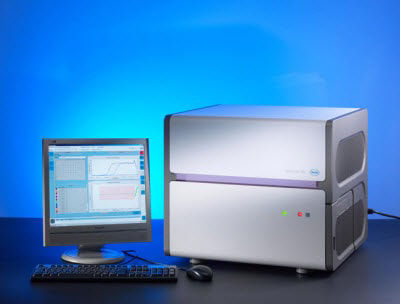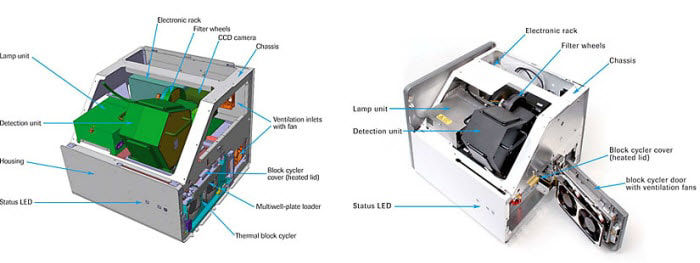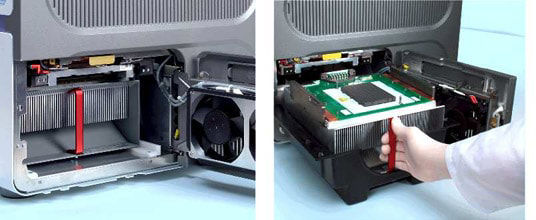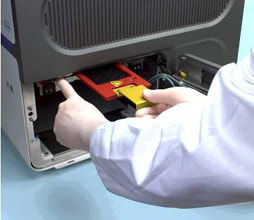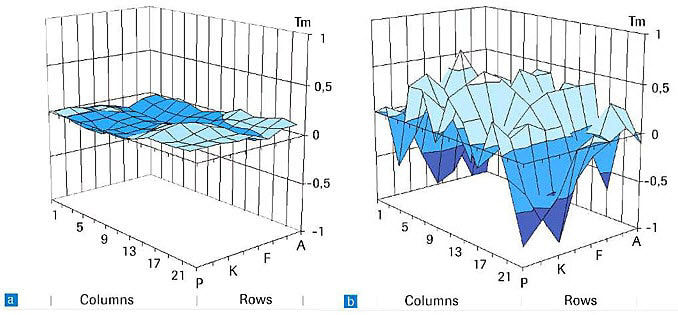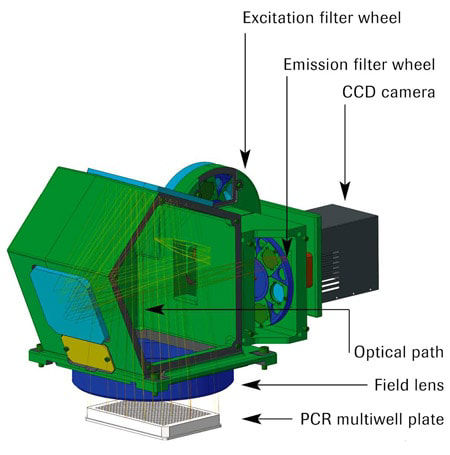General Design
The LightCycler® 480 Real-Time PCR System features a compact and versatile benchtop instrument that includes interchangeable silver thermal block cycler unit. Users can flexibly switch between 96- and 384-mulitiwell plate formats, or choose between clear or white LightCycler® 480 multiwell plates.
Figure 1: LightCycler® 480 Instrument with workstation
Figure 2: Inner view of the LightCycler® 480 Instrument instrument with its building blocks.
Benefit from an Innovative Silver Thermal Block Cycler for Unmatched Temperature Homogeneity
PCR specificity and yield are directly related to the ability of the thermal-cycling system to rapidly and accurately arrive at and maintain reaction temperatures. Roche set standards in real-time PCR speed and accuracy a decade ago with the capillary-based LightCycler® 1.5 and 2.0 Systems. To achieve the same performance in a 96- or 384-well format, a new type of thermal block cycler was integrated into the LichtCycler® 480 Real-Time PCR System. Heating and cooling is achieved using Peltier elements. Additionally, the novel thermal block cycler incorporates Therma-Base technology for optimal heat transfer and distribution to all samples on a multiwell plate (see Figure 3). The Therma-Base unit, located beneath the Peltier elements, ensures optimal heat distribution across the plate and, as a consequence, optimized well-to-well homogeneity as well as maximized inter-well assay reproducibility. The cooling element below the Therma-Base unit features a maximized inner surface area to facilitate rapid heat absorption.
Figure 3: LightCycler® 480 384-well thermal block cycler (left) and cross-section showing the integration of the Therma-Base (right). The Therma-Base is based on evaporation and condensation of a working fluid in a thin vacuum chamber enabling rapid heat distribution and temperature equilibration.
The high-performance silver thermal block cycler built into the LightCycler® 480 System enables completion of a PCR run within 40 minutes (384-well block), simultaneously enabling maximized homogeneity during heating and cooling over a broad temperature range for many targets and applications.
The 96- and 384-well thermal block cyclers are easily interchangeable (see Figure 4) by users within minutes for adaptation to different throughput needs. Recalibration is not required after block exchange.
Figure 4: Exchange of the LightCycler® 480 Block Cycler unit and cover. Automatic cycler and cover identification by the system eliminates time-consuming recalibration runs.
Demonstration of LightCycler® 480 Thermal Block Cycler Temperature Homogeneity
Temperature homogeneity is a major prerequisite for qPCR reproducibility across a multiwell plate. Melting temperature (Tm) analysis provides a powerful and highly sensitive tool for monitoring (see Figure 5). In a corresponding experimental setup, the same reaction mix (an oliognucleotide bound to a complementary SimpleProbe probe) is added to wells at many different positions on the plate and fluorescence is monitored while the temperature is raised slowly at a constant rate. At the specific melting temperature of the reaction mix, the decrease of fluorescence reaches a maximum. Highly reproducible Tm values are only observed if during the melting process the temperature reaches the same value simultaneously everywhere on the plate (see Figure 5a). On the other hand, inhomogeneous heating (e.g., on conventional block cyclers without Therma-Base) leads to melting temperatures that appear higher or lower than the expected value (see Figure 5b).
Figure 5: Influence of the Therma-Base layer on temperature homogeneity across a 384-well plate. Left: LightCycler® 480 Real-Time PCR System including Therma-Base; right: another real-time PCR system without Therma-Base.
Advanced High-Performance Optical System
The excellent performance of the LightCycler® 480 Instrument´s optical system stems from a high-intensity Xenon lamp which emits light across a broad spectrum. Flexible combination of the built-in filters for specific excitation and emission allows the use of a variety of fluorescent dyes and detection formats (see Table 1) for any current real-time PCR application (e.g., melting curve-based genotyping with HybProbe probes).
Figure 6: Schematic cross-section of the LightCycler® 480 detection unit. The special arrangement of optical components and the optimum focal length in the LightCycler® 480 Real-Time PCR System ensure specific signal excitation and uniform data collection across the entire multiwell plate, independent of sample position.
| Assay/Detection Format | Dyes | Excitation (nm) | Detection (nm) |
| SYBR Green l, HRM | SYBR Green I ResoLight HRM dye |
465 | 510 |
| Hydrolysis Probe / UPL Probe Monocolor / RealTime ready assays | FAM | 465 | 510 |
| Hydrolysis Probes / UPL Probes Dual Color* |
FAM VIC / Hex / Yellow 555 |
465 533 |
510 580 |
| Hydrolysis Probes 3 Colors |
FAM VIC / Hex Cy 5 / Cy 5.5 |
465 533 618 |
510 580 660 |
| Hydrolysis Probes 4 Colors |
LightCycler® Cyan 500 FAM LightCycler® Red 610 Cy 5 / Cy 5.5 |
440 498 533 618 |
488 580 610 660 |
| HybProbe Probes Monocolor |
Fluorescein (Donor) LightCycler® Red 640 |
498 | 640 |
| HybProbe Probes Multicolor |
Fluorescein (Donor) LightCycler® Red 610 LightCycler® Red 640 Cy 5 / Cy 5.5 |
465 498 498 498 |
510 610 640 660 |
* Universal color compensation objects for dual color FAM/VIC and UPL assays. Table 1: Overview of excitation and emission filters, dyes and detection formats. The LightCycler® 480 Real-Time PCR System employs a high-intensity Xenon lamp that emits light over a broad wavelength range (430–630 nm). The five excitation and six emission filters of the system can be used in any combination.
The choice between multiple filter combinations for excitation and emission enables optimized excitation as well as a reduction of crosstalk between different dyes in the reaction mix. The filters are placed in two filter wheels and offer five different wavelengths for excitation (440, 465, 498, 533, and 618 nm) and six for detection (488, 510, 580, 610, 640, and 660 nm). They can be freely combined according to the requirements of the probe formats and dyes used in an experiment.
Key benefits of the LightCycler® 480 optical system:
- Highest flexibility in the choice of fluorescence dyes and detection formats for all current PCR applications, including high resolution melting (HRM).
- Accurate data capture across the entire plate.
- New long-pass filter (705 nm detection).
- Enhanced multiplexing capabilities for 4-color hydrolysis probe and 3-color HybProbe probe assays with pre-defined templates.
- Optimal performance of dual color Hydrolysis Probes assay supported by universal color compensation objects for FAM / VIC or Universal ProbeLibrary dual color assays.
Products are for Life Science Research Use Only, not for use in diagnostic procedures, unless otherwise indicated.

